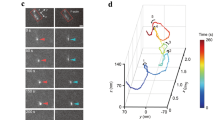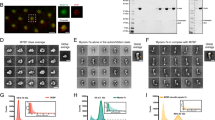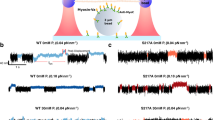Abstract
Myosin X is involved in the reorganization of the actin cytoskeleton and protrusion of filopodia. Here we studied the molecular mechanism by which bovine myosin X is regulated. The globular tail domain inhibited the motor activity of myosin X in a Ca2+-independent manner. Structural analysis revealed that myosin X is monomeric and that the band 4.1-ezrin-radixin-moesin (FERM) and pleckstrin homology (PH) domains bind to the head intramolecularly, forming an inhibited conformation. Binding of phosphatidylinositol-3,4,5-triphosphate (PtdIns(3,4,5)P3) to the PH domain reversed the tail-induced inhibition and induced the formation of myosin X dimers. Consistently, disruption of the binding of PtdIns(3,4,5)P3 attenuated the translocation of myosin X to filopodial tips in cells. We propose the following mechanism: first, the tail inhibits the motor activity of myosin X by intramolecular head-tail interactions to form the folded conformation; second, phospholipid binding reverses the inhibition and disrupts the folded conformation, which induces dimer formation, thereby activating the mechanical and cargo transporter activity of myosin X.
This is a preview of subscription content, access via your institution
Access options
Subscribe to this journal
Receive 12 print issues and online access
$189.00 per year
only $15.75 per issue
Buy this article
- Purchase on Springer Link
- Instant access to full article PDF
Prices may be subject to local taxes which are calculated during checkout







Similar content being viewed by others
References
Berg, J.S., Derfler, B.H., Pennisi, C.M., Corey, D.P. & Cheney, R.E. Myosin-X, a novel myosin with pleckstrin homology domains, associates with regions of dynamic actin. J. Cell Sci. 113, 3439–3451 (2000).
Knight, P.J. et al. The predicted coiled-coil domain of myosin 10 forms a novel elongated domain that lengthens the head. J. Biol. Chem. 280, 34702–34708 (2005).
Tokuo, H. & Ikebe, M. Myosin X transports Mena/VASP to the tip of filopodia. Biochem. Biophys. Res. Commun. 319, 214–220 (2004).
Zhang, H. et al. Myosin-X provides a motor-based link between integrins and the cytoskeleton. Nat. Cell Biol. 6, 523–531 (2004).
Weber, K.L., Sokac, A.M., Berg, J.S., Cheney, R.E. & Bement, W.M. A microtubule-binding myosin required for nuclear anchoring and spindle assembly. Nature 431, 325–329 (2004).
Homma, K., Saito, J., Ikebe, R. & Ikebe, M. Motor function and regulation of myosin X. J. Biol. Chem. 276, 34348–34354 (2001).
Homma, K. & Ikebe, M. Myosin X is a high duty ratio motor. J. Biol. Chem. 280, 29381–29391 (2005).
Ikebe, M. Regulation of the function of mammalian myosin and its conformational change. Biochem. Biophys. Res. Commun. 369, 157–164 (2008).
Kolomeisky, A.B. & Fisher, M.E. Molecular motors: a theorist's perspective. Annu. Rev. Phys. Chem. 58, 675–695 (2007).
Sun, Y. et al. Single-molecule stepping and structural dynamics of myosin X. Nat. Struct. Mol. Biol. 17, 485–491 (2010).
Kerber, M.L. et al. A novel form of motility in filopodia revealed by imaging myosin-X at the single-molecule level. Curr. Biol. 19, 967–973 (2009).
Watanabe, T.M., Tokuo, H., Gonda, K., Higuchi, H. & Ikebe, M. Myosin-X induces filopodia by multiple elongation mechanism. J. Biol. Chem. 285, 19605–19614 (2010).
Berg, J.S. & Cheney, R.E. Myosin-X is an unconventional myosin that undergoes intrafilopodial motility. Nat. Cell Biol. 4, 246–250 (2002).
Sousa, A.D., Berg, J.S., Robertson, B.W., Meeker, R.B. & Cheney, R.E. Myo10 in brain: developmental regulation, identification of a headless isoform and dynamics in neurons. J. Cell Sci. 119, 184–194 (2006).
Li, X.D., Jung, H.S., Mabuchi, K., Craig, R. & Ikebe, M. The globular tail domain of myosin Va functions as an inhibitor of the myosin Va motor. J. Biol. Chem. 281, 21789–21798 (2006).
Umeki, N. et al. The tail binds to the head-neck domain, inhibiting ATPase activity of myosin VIIA. Proc. Natl. Acad. Sci. USA 106, 8483–8488 (2009).
Wang, F. et al. Regulated conformation of myosin V. J. Biol. Chem. 279, 2333–2336 (2004).
Li, X.D., Mabuchi, K., Ikebe, R. & Ikebe, M. Ca2+-induced activation of ATPase activity of myosin Va is accompanied with a large conformational change. Biochem. Biophys. Res. Commun. 315, 538–545 (2004).
Li, X.D. et al. The globular tail domain puts on the brake to stop the ATPase cycle of myosin Va. Proc. Natl. Acad. Sci. USA 105, 1140–1145 (2008).
Krementsov, D.N., Krementsova, E.B. & Trybus, K.M. Myosin V: regulation by calcium, calmodulin, and the tail domain. J. Cell Biol. 164, 877–886 (2004).
Levental, I. et al. Calcium-dependent lateral organization in phosphatidylinositol 4,5-bisphosphate (PIP2)- and cholesterol-containing monolayers. Biochemistry 48, 8241–8248 (2009).
Homma, K., Yoshimura, M., Saito, J., Ikebe, R. & Ikebe, M. The core of the motor domain determines the direction of myosin movement. Nature 412, 831–834 (2001).
Nagy, S. et al. A myosin motor that selects bundled actin for motility. Proc. Natl. Acad. Sci. USA 105, 9616–9620 (2008).
Yang, Y. et al. A FERM domain autoregulates Drosophila myosin 7a activity. Proc. Natl. Acad. Sci. USA 106, 4189–4194 (2009).
Tokuo, H., Mabuchi, K. & Ikebe, M. The motor activity of myosin-X promotes actin fiber convergence at the cell periphery to initiate filopodia formation. J. Cell Biol. 179, 229–238 (2007).
Sasaki, A.T., Chun, C., Takeda, K. & Firtel, R.A. Localized Ras signaling at the leading edge regulates PI3K, cell polarity, and directional cell movement. J. Cell Biol. 167, 505–518 (2004).
Reynard, A.M., Hass, L.F., Jacobsen, D.D. & Boyer, P.D. The correlation of reaction kinetics and substrate binding with the mechanism of pyruvate kinase. J. Biol. Chem. 236, 2277–2283 (1961).
Spudich, G. et al. Myosin VI targeting to clathrin-coated structures and dimerization is mediated by binding to Disabled-2 and PtdIns(4,5)P2. Nat. Cell Biol. 9, 176–183 (2007).
Jung, H.S., Komatsu, S., Ikebe, M. & Craig, R. Head-head and head-tail interaction: a general mechanism for switching off myosin II activity in cells. Mol. Biol. Cell 19, 3234–3242 (2008).
Burgess, S.A., Walker, M.L., Thirumurugan, K., Trinick, J. & Knight, P.J. Use of negative stain and single-particle image processing to explore dynamic properties of flexible macromolecules. J. Struct. Biol. 147, 247–258 (2004).
Acknowledgements
We thank R. Fenton (University of Massachusetts) for reading the manuscript and K. Homma for the parent construct of myosin X. This work was supported by US National Institutes of Health (NIH) grants DC006103, AR048526, AR048898 and HL073050 to M.I. and Korea Basic Science Institute grant T31760 to H.S.J.
Author information
Authors and Affiliations
Contributions
N.U. performed the ATPase assays of myosin X constructs, cross-linking assay and prepared myosin X proteins for EM experiments. H.S.J. performed EM image analysis and wrote the EM part of the paper. T.S. performed lipid binding assay, cross-linking, cell imaging, measurement of the activity of PH domain mutants and production of some myosin X constructs. O.S. performed the actin gliding assay of myosin X. R.I. prepared myosin X expression constructs. M.I. supervised the whole project and wrote the paper.
Corresponding author
Ethics declarations
Competing interests
The authors declare no competing financial interests.
Supplementary information
Supplementary Text and Figures
Supplementary Figures 1–8 and Supplementary Methods (PDF 5877 kb)
Rights and permissions
About this article
Cite this article
Umeki, N., Jung, H., Sakai, T. et al. Phospholipid-dependent regulation of the motor activity of myosin X. Nat Struct Mol Biol 18, 783–788 (2011). https://doi.org/10.1038/nsmb.2065
Received:
Accepted:
Published:
Issue Date:
DOI: https://doi.org/10.1038/nsmb.2065
This article is cited by
-
How myosin VI traps its off-state, is activated and dimerizes
Nature Communications (2023)
-
Phenotypic analysis of Myo10 knockout (Myo10tm2/tm2) mice lacking full-length (motorized) but not brain-specific headless myosin X
Scientific Reports (2019)
-
Myosin X is required for efficient melanoblast migration and melanoma initiation and metastasis
Scientific Reports (2018)
-
Myosin-X knockout is semi-lethal and demonstrates that myosin-X functions in neural tube closure, pigmentation, hyaloid vasculature regression, and filopodia formation
Scientific Reports (2017)
-
Activated full-length myosin-X moves processively on filopodia with large steps toward diverse two-dimensional directions
Scientific Reports (2017)



